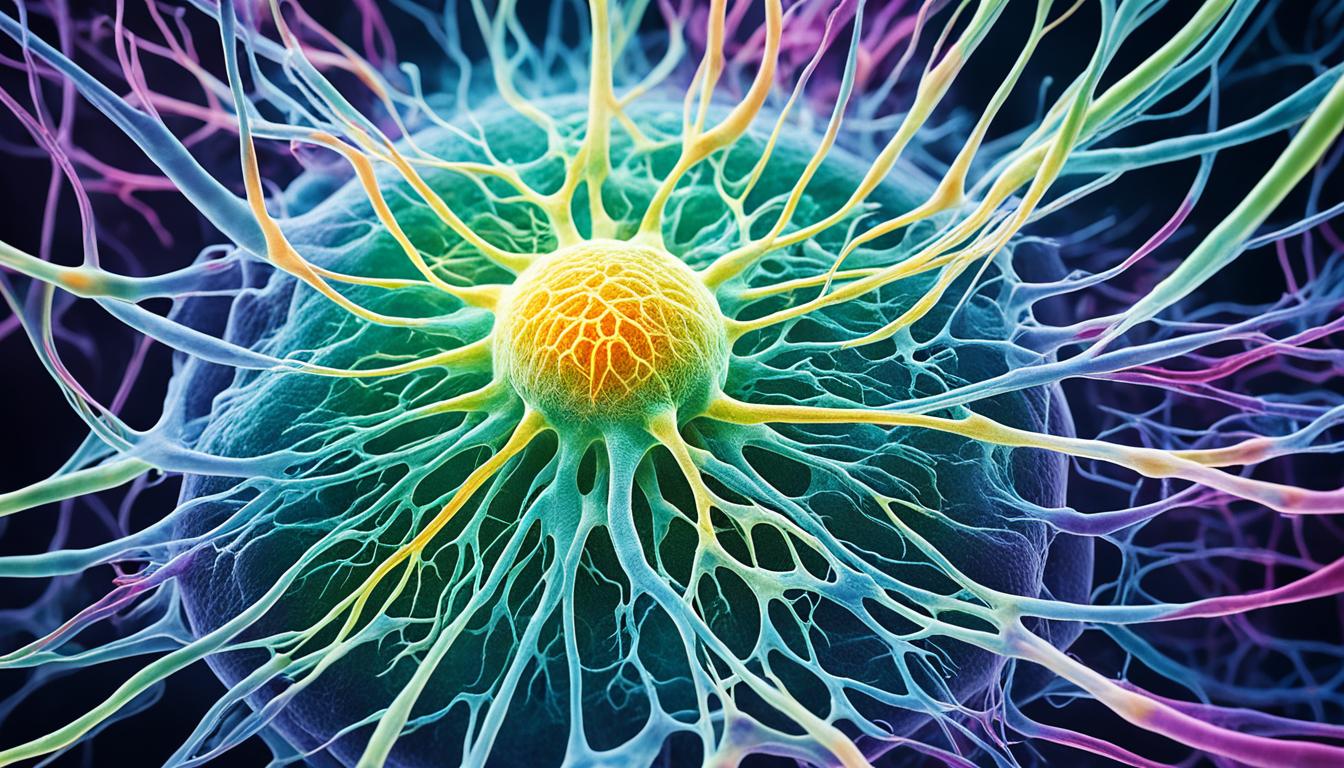Primary Lateral Sclerosis (PLS) is a kind of motor neuron disease. It affects the nerve cells in the brain that help control movement. Someone with PLS may have muscle stiffness, weakening muscles, and find it hard to control their muscles.
Diagnosing PLS is hard because it’s similar to conditions like multiple sclerosis and ALS. Doctors use different tests like bloodwork, MRI, EMG, and lumbar puncture to make sure it’s PLS and not something else.
There isn’t a cure for PLS yet. But, people with PLS can use different treatments to help with symptoms and make life better. This includes medicine, therapies, speech therapy, and devices to help with daily activities.
Stem cell therapy is a new area being looked into for PLS. But, we still need more research to know if it really helps. Scientists are working to see if stem cells can help with PLS by improving muscle function and slowing the disease down.
Key Takeaways:
- PLS is a neurodegenerative disease that badly affects the brain’s nerve cells. This can cause muscle stiffness, muscle weakness, and trouble with muscle control.
- Diagnosing PLS can be tricky because it’s similar to other conditions like multiple sclerosis and ALS.
- Treatment for PLS right now is all about managing the symptoms and trying to keep up normal daily functions. Unfortunately, there is no cure yet.
- There are different ways to help make life better for those with PLS. This includes using medicines, therapies, and devices that help with daily activities.
- Stem cell therapy is being looked at as a possible treatment for PLS. But we need more research to understand if it works.
Symptoms of PLS
Primary Lateral Sclerosis (PLS) shows various symptoms from person to person. Its signs include tightness in muscles, gradual muscle weakness, and spasticity. These usually start in the legs and can move to the arms, hands, and even the tongue and jaw.
People with PLS might also face other issues like:
- Hoarse voice: It can make your voice sound rough or tired.
- Slowed speech: This makes talking harder and slower.
- Chewing and swallowing difficulties: It can cause problems with chewing and eating.
- Emotional changes: Mood swings and intense feelings can happen too.
- Breathing problems: Breathing might be hard because of weak respiratory muscles.
- Bladder problems: It might affect how well you can control your bladder.
These symptoms usually get worse over time, affecting your movement and daily life. Seeing a doctor early is crucial for a clear diagnosis and proper treatment.
| Symptom | Description |
|---|---|
| Muscle stiffness | A feeling of increased resistance or difficulty in moving specific muscles or muscle groups. |
| Progressive muscle weakness | Gradual loss of muscle strength and function, which worsens over time. |
| Spasticity | Involuntary muscle contractions or spasms that can cause stiffness and tightness. |
| Hoarse voice | A change in the voice quality, often characterized by a rough or strained sound. |
| Slowed speech | Speech that is significantly slower or more difficult than usual. |
| Chewing and swallowing difficulties | Issues with chewing or swallowing food and liquids, possibly leading to choking or aspiration. |
| Emotional changes | Unexplained shifts in mood, ranging from intense emotions to episodes of apathy or depression. |
| Breathing problems | Difficulties with breathing, such as shortness of breath or shallow breathing, due to weakened respiratory muscles. |
| Bladder problems | Changes in bladder control, leading to urinary incontinence, urgency, or frequency. |
Remember, these symptoms can be like other conditions, so a correct diagnosis is key for the right care and plan.
Causes and Risk Factors of PLS
The exact cause of Primary Lateral Sclerosis (PLS) is unknown. It’s a disease where the upper motor neurons in the brain break down. Most often, PLS isn’t passed down in families, but sometimes it is through genetic mutations.
Changes in the ALS2 gene have been linked to some cases of PLS. These changes can be passed on by parents to their child. This happens when both parents carry and pass on the mutated gene.
Experts think environmental factors might have a role in PLS, but nothing is certain yet. More research is necessary to understand these and other factors better in PLS development.
Risk Factors for Primary Lateral Sclerosis
| Factors | Description |
|---|---|
| Genetic Mutations (ALS2 Gene) | In some rare cases, changes in the ALS2 gene can lead to PLS. This can be passed down through families via an autosomal recessive pattern. |
| Autosomal Recessive Inheritance | PLS can be inherited this way if both parents have and pass on the mutated gene. |
| Environmental Factors | We don’t completely understand the role of the environment in PLS. No specific risk factors have been identified yet. |
While the causes of PLS are still a mystery, knowing about genetic and possible environmental factors is key. This knowledge can help us find better treatments for this disease.
Conclusion
Primary Lateral Sclerosis (PLS) is a type of motor neuron disease. It leads to weaker muscles and other nerve symptoms. Right now, there’s no cure for PLS.
But, there are treatments to help manage its effects. Medicines can lessen muscle tightness and mood swings. Physical and occupational therapy can keep muscles powering well and help with moving.
For trouble with speaking or swallowing, speech therapy can help. Proper nutrition is important too. Devices and tech can make communication easier and help with daily tasks.
Stem cell therapy might be a new hope for treating PLS. But, it needs more study to confirm its benefits.
Early detection and full care are key in dealing with PLS. A mix of treatments, drugs, and other help can improve life for PLS patients. It can help them stay active in their daily routines.

